
Groups Petition To List Olympic Peninsula Steelhead Under ESA
The clock is ticking for the feds to decide whether an Endangered Species Act listing may be warranted for Washington’s Olympic Peninsula steelhead.
The Wild Fish Conservancy and The Conservation Angler requested the National Marine Fisheries Service list the prized fish as either threatened or endangered in an August 1 petition, initiating a process that could lead to further reviews and possibly a listing down the road if one is found to be warranted, or not.

“We have 90 days to make an initial finding as to whether it merits a full review, and that is where we are currently,” stated Michael Milstein, a NMFS spokesman for the West Coast Region, early this afternoon.
It not only has implications for the steelhead but state and tribal fisheries and remote communities that otherwise are quiet in winter.
Rivers that fall under the petition include some of the Evergreen State’s “crown jewel” fisheries, including the Quillayute and its tribs, the Dickey, Sol Duc, Calawah and Bogachiel, as well as the Hoh, Queets and Quinault, along with all other streams between the Copalis and Lyre Rivers.
WFC and TCA claim that the peninsula’s summer-runs are “nearly extinct” and its winter-run stock is “declining and losing its life history diversity.”
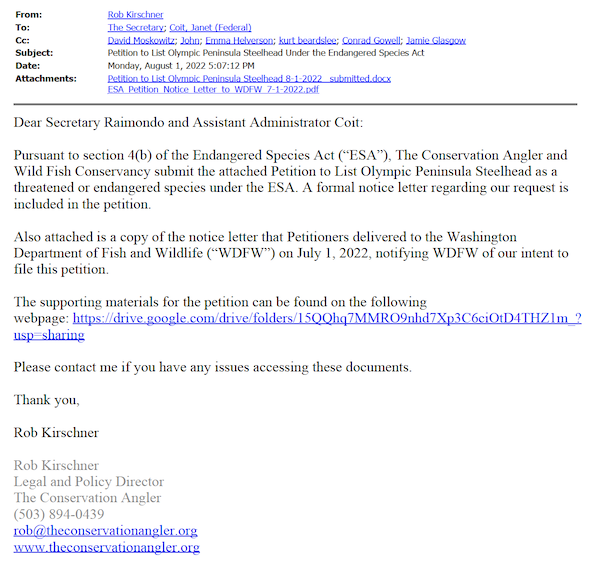
“The fate of the species now rests on a depressed and contracted mid- to late-spring component of wild fish whose productivity is limited or declining depending on the population. The remnants of these runs that historically numbered in the tens of thousands face declining freshwater and marine habitat conditions, increasing recreational fishing pressure, and ongoing commercial harvest. Because of these and other demographic and ecological threats, Olympic Peninsula steelhead are likely to become endangered within the foreseeable future,” they argue.
The Duvall- and Edmonds-based organizations also request critical habitat be designated for the fish stock in their 166-page filing.
They notified WDFW of the pending petition with an early July letter to Director Kelly Susewind, their petition shows.
“We plan to review the petition and will be happy to provide information to NMFS about steelhead on the Olympic Peninsula if requested,” stated Nate Pamplin, WDFW external affairs director, late this afternoon. “We are committed to steelhead conservation and optimizing opportunities for anglers. We are working hard with partners and the public on a framework that would inform the development of long-term steelhead management plans for the Olympic Peninsula. An ESA listing isn’t one of the management tools we would use at this point in time.”
The dark cloud of a potential listing petition has been on the horizon in recent years as wild runs have sagged coastwide. Just 25,723 winter fish were counted on the gravel during the 2020-21 run, a new low mark and roughly half of what it was in 2015, the year of the Blob. A WDFW bi-weekly report from late spring or early summer of that year reported the dewatering of small steelhead streams and raccoons digging up redds. Ocean conditions since have been poor for Washington Coast steelhead as well.
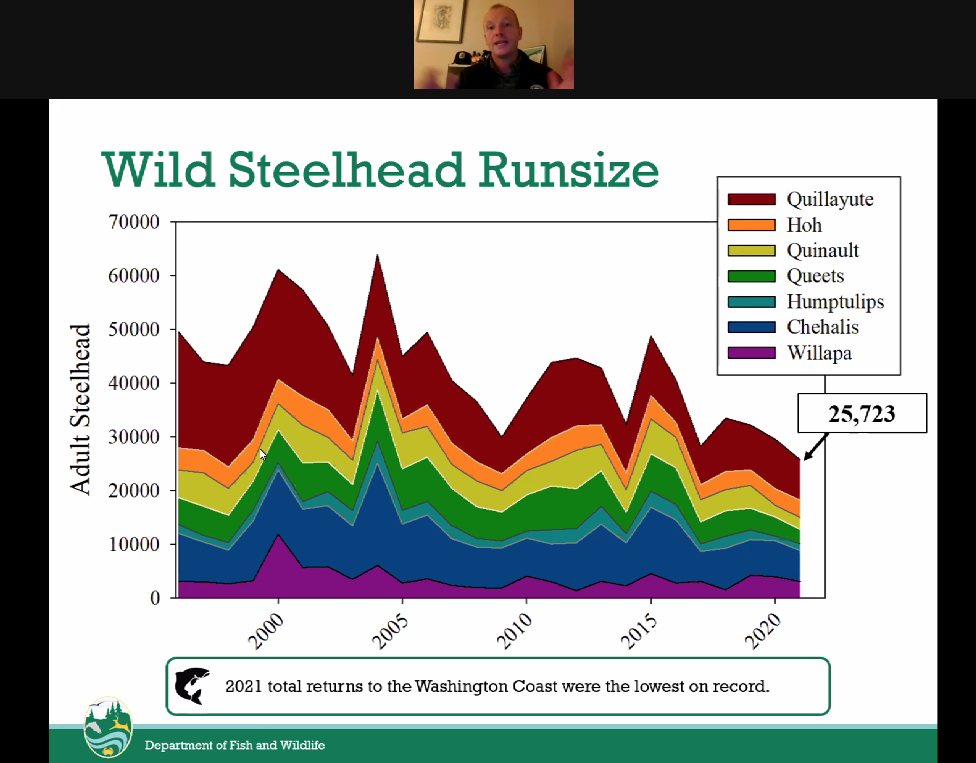
In response to low forecasts, WDFW has implemented unprecedented sweeping steelheading restrictions the past two winter seasons. During 2020-21, blanket rules for Olympic Peninsula, Grays Harbor and Willapa Bay streams banned fishing out of a boat, as well as bait and scents, and anglers could only fish with a single barbless hook.
And last winter was even more restricted, with fishing closed on the Quinault, Queets, Chehalis and Humptulips because of below-escapement forecasts. Some anglers had called for a full closure, but the rivers that remained open for hatchery harvest and wild catch-and-release were shut down a month early, at the start of March, because of WDFW’s fears that returns were coming in “well below forecast – not just a little bit, but significantly.”
At the time anglers and guides disputed that, reporting that they were seeing more fish around during low, clear flows. That may be born out by a WDFW presentation on coastal steelhead for Friday’s Fish and Wildlife Commission meeting. It shows spawning escapement increases over 2020-21 in the Quillayute and Hoh systems, which were open to fishing till March 1, including from a boat on the former.
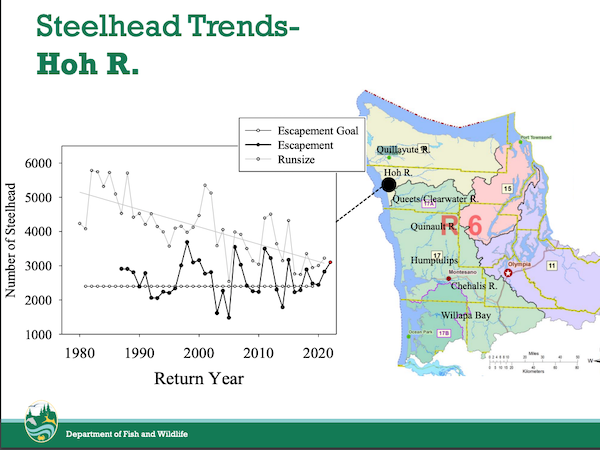
(On the flip side, even without recreational fishing, returns to the Chehalis, Humptulips, Upper Quinault and Queets-Clearwater came in below escapement goals, as expected. Arguably, Chehalis system steelhead are in worse shape than OlyPen streams, so it’s unclear why WFC/TCA didn’t go after them first.)
Last winter’s restrictions also came at the cost of an untapped Skookumchuck Hatchery steelhead return that surplussed 2,282 fish to local lakes and food banks.
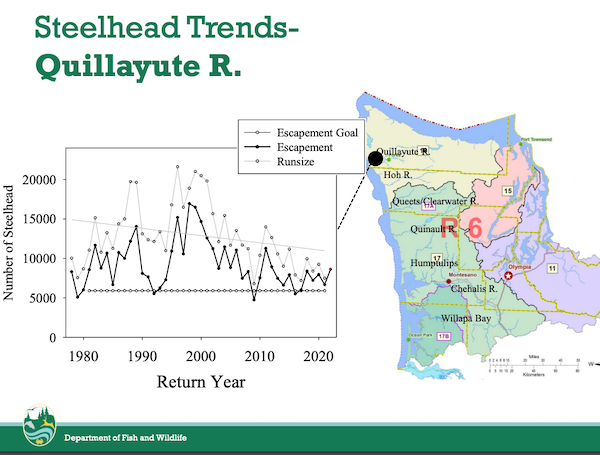
While the 90-day mark for NMFS’s review of the WFC/TCA petition lands around Halloween, the agency’s Milstein said there is a little leeway. Pointing to a “to the maximum extent practicable” clause, he noted the feds have nearly 10 listing petitions on their collective desk, for everything from bull kelp to sea stars, salmon to steelhead, “so we are pretty well booked.”
The feds could deny the petition with a “negative 90-day finding” and post that on the Federal Register, or they could find that it presents enough information that a listing may be warranted. If it’s the latter, Olympic Peninsula steelhead would then be considered a “candidate” stock for ESA protections and NMFS would call for public comment and perform a status review and peer review. After that point, the feds would make another determination, a “12-month finding” that a listing is either “not warranted” or “warranted.”
A warranted recommendation would lead to a proposed rule and another round of public comment, then a final decision to either withdraw the proposal or publish it on the Federal Register.
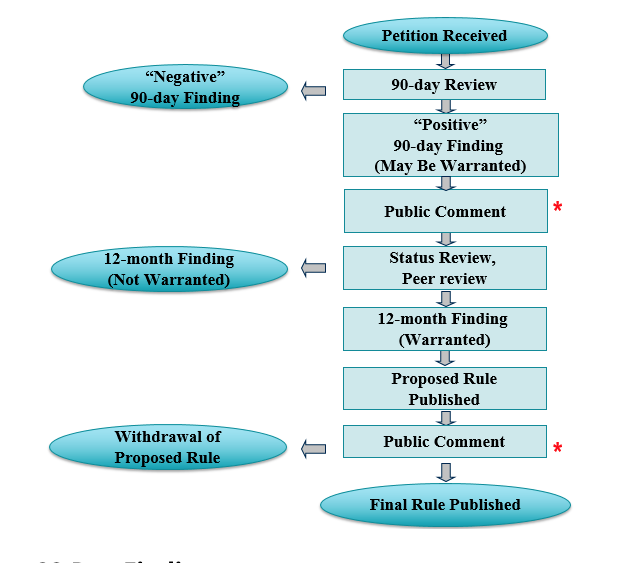
As it stands, Washington steelhead ESA listings include fish in Puget Sound and the Columbia-Snake system upstream of the Cowlitz.
In Puget Sound, even as WDFW had altered hatchery practices to, among other things, do away with off-station releases (wild C&R fisheries ended well before ESA protection was granted), the 2007 listing opened the state up to litigation from the Wild Fish Conservancy over hatchery genetic management plans waiting on federal approval or review. A 2014 WFC lawsuit limited smolt releases to up to 521,000 and into just four watersheds, Snohomish, Stillaguamish, Nooksack and Dungeness. It took nearly a decade to reopen the Skagit for a late winter-spring catch-and-release fishery due to paperwork and runsize needs.
As it stands, tomorrow afternoon the Fish and Wildlife Commission is set to be briefed on last winter’s run, prospects for this season and the process for setting regulations. In late 2015, the commission ended retention of wild steelhead on the Olympic Peninsula, a rule change that took effect with the 2016-17 season and effectively ended the sport harvest of natural-origin steelies in state waters. In early 2010, members reduced the wild steelhead retention period on eight West End rivers by two and a half months, starting with the 2010-11 season. Prior to that, harvest had been limited to one a year.
More details about WDFW’s coastwide steelhead planning is available on the agency’s website.
